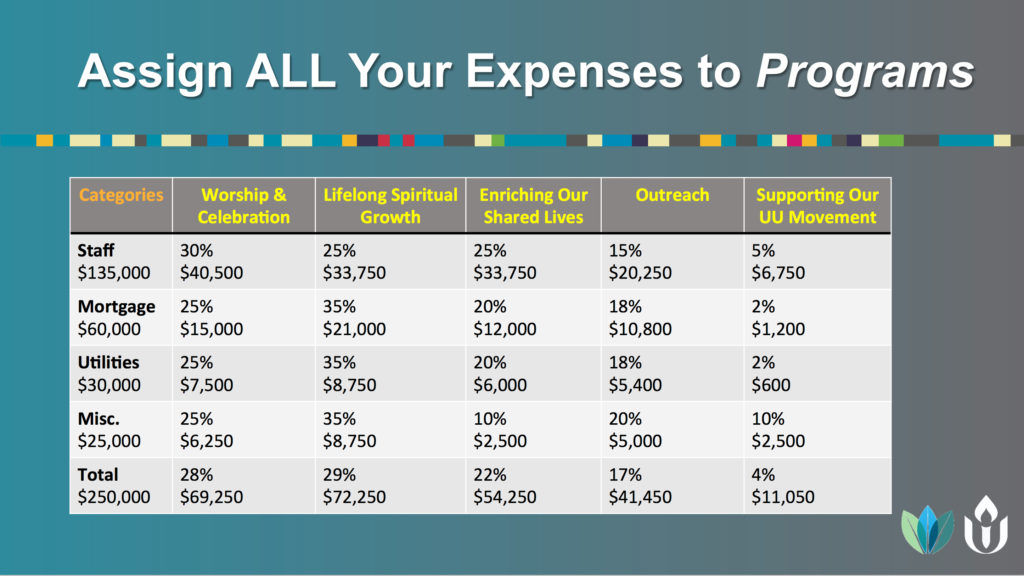In Part I, the focus was on a monthly program testimonial for year-round messaging on WHAT you accomplish and WHY (see Ideas to Boost Funding for Your Programs – PART I ). In Part II, let’s think about the visual way we represent our funding needs at an annual meeting and/or in our annual pledge drives.
Do you focus on salaries and your facilities as a percentage of your budget in a spreadsheet? Congregations need to keep a detailed list of expenses, but when it’s time to gather pledges, a line-item budget is not a compelling way to have your members and friends financially support your programs.
Let’s focus on the bigger picture.
Why do you have professional staff and, for many congregations, your own building? To help lead or enhance your programs and have a place to house those programs.

When you are informing the congregation about your expenses, you can present that information in a way that is both transparent AND program-focused. The latter component, a representation of a program-based budget, is important in order to show WHY you have these expenses.
I have seen many a well-intentioned stewardship team use a pie chart with the following categories: Salaries/Staff; Building/Utilities; UUA/Regional dues; Share-the-Plate; and Miscellaneous. All those things are technically accurate, however, congregations don’t exist to pay salaries and mortgages – they exist for the programs that happen in your building and that are facilitated by the minister(s) and staff.
To gather the information for a program-based budget, ask your minister(s) and staff to give you percentages of their time spent on the following programs:
- Worship & Celebration
- Lifelong Spiritual Growth
- Enriching Our Shared Lives
- Outreach/Social Justice
- Supporting Our UU Movement
You an also assign your building expenses to each of these categories. Here’s an example:

This table still gives detail, for those who might want it, but more importantly it provides the basis for a pie chart that shows your expenses in terms of programs and your mission.

As always, one size does not fit all in terms of the percentage allocation. Every congregation is different, but all congregations can show their expenses as they relate to programs and mission. Help everyone visualize how their giving translates into what you accomplish together.
Kay Crider is a stewardship consultant with the Stewardship for Us team, supporting the UUA. Kay can be reached at kay@stewardshipforus.com, via UUA Congregational Life, (http://www.uua.org/finance/fundraising) or via the Pacific Western Region staff.

Kay has more than 24 years of successful professional fundraising experience. She is passionate about helping organizations fund their mission with strategic, intentional stewardship. Reach her at kay@stewardshipforus.com.


I appreciate what you are suggestions—and I realize that I am usually an outlier—but for me, those categories are so vague (and “worship” is something I never do, the word irritates me consistently) that I am left wondering what the most of categories really mean: “enriching our shared lives” could be just about anything; what are we celebrating? Supporting the UU movement and outreach are fairly clear, but I am one who will not spend a dime without knowing details. I suggest lots of footnotes with these—those who do not want them may ignore them, but the rest of us will feel more secure that responsible management is in place.
Hi Sally – You can name the Worship & Celebration piece of the pie “Sunday Services” or “Sunday Spiritual Exploration” or whatever feels right for your congregation. For some, the “celebration” piece is the music, sharing, and other aspects of Sunday morning. “Enriching Our Shared Lives” refers to all the activities you do together as a congregation that are not on Sundays and not Outreach, such as lay pastoral programs/caring for each other, covenant groups/small ministry groups, sister circles/men’s groups, etc. and can be referred to as “Community Within” or other name that speaks to your congregation, as distinguished from Outreach and what you do in the wider community. Some folks do like to see spreadsheets but many do not and are not ignoring that piece, it’s just not a compelling way for them to understand the meaning and the WHY behind their gifts that fund the programs and the mission. Best, Kay
Thanks for the explanations—I think that at least the first few years (and probably ongoing, as new people are apt to show up at any time), some explanation like that would be helpful—as well as instructions about how to dig into the details if you are the sort of person who wants them.
I am probably reacting to a specific situation at my society, where we have acknowledged communication as a problem for at least 8 years, but have not made noticeable progress in addressing it. sigh
I agree that these non accounting categories are nebulous at best, and I agree that congregation members are not excited or want to give based on expense accounts. Having said that, I have yet to see any meaningful way to allocate accounting costs accurately to the program type budget. Any suggestions as to how to do that accurately?
We at WUU have done this on and off for a decade since I attended a workshop at SUUSI that recommended it. I set up a proportion table by major line item–once the table is set up it can be plugged into the line item budget for any year. The table and the pie chart are what is shown to the congregation at the Annual Meeting. [The FInance Committee still uses the line item budget, of course]. It’s also used in the Annual Campaign. Members appear to like it–and I always stress that the spreadsheets can be shown and reviewed if the congregation would like to see tiem (spreadsheets are close to toxic so there are usually no takers….)